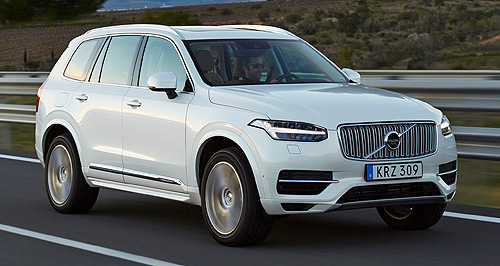Make / Model Search
Future models - Volvo - EVAll-new EV to underpin Volvo eco pushAll the way with CMA: Volvo’s new Compact Modular Architecture will underpin the next 40 series and other models, accommodating plug-in hybrid and, for the first time, full-electric powertrains. Volvo’s first EV on sale by 2019 as it ramps up electrified cars across full rangeGallery Click to see larger images 16 Oct 2015 By TERRY MARTIN VOLVO Cars expects electrified vehicles to account for up to 10 per cent of its global sales by the end of this decade, with the Swedish manufacturer’s first full-electric car on sale by 2019 and plug-in hybrids to be introduced across its entire model range. Volvo Car Australia has also this week forecast that 10 per cent of its sales will be electrified cars, but in a shorter timeframe – before the end of 2017. One of several manufacturers to emphasise electrification over diesel with its future powertrains in in the wake of the Volkswagen emissions-rigging scandal, Volvo has confirmed that it will introduce an all-new 40 series based on a newly developed ‘Compact Modular Architecture’ (CMA) that will support both plug-in and pure-electric vehicles. The first models based on the CMA platform are due for release in 2017. The Scalable Product Architecture (SPA) underpinning the new 90 series – starting with the recently launched redesigned XC90 – also supports both plug-in hybrid and battery electric powertrain configurations, with Australia set to launch the XC90 T8 Twin Engine petrol-based plug-in hybrid early next year. This will be followed by plug-in hybrid versions of the forthcoming new S90 luxury sedan and other models in the so-called 90 cluster, while the new-generation 60 series – also based on SPA – will follow suit. Included among these will be a new front-wheel-drive Twin Engine variant, extending beyond the current all-wheel-drive configuration. While Volvo has previously committed to a broad range of plug-in hybrid models, the promise of a pure-electric car – details of which are still to be divulged – marks a new direction for the brand. Volvo Cars Group product manager Lars Lagstrom told GoAuto at the global launch of the XC90 earlier this year that full-electric vehicles were not yet a priority. “Our (SPA) platform can do most of it, but we don’t see the full-electric vehicle is there yet,” he said. “The infrastructure is not there. I mean, Tesla is struggling to build up the superchargers and so on. “We see it (plug-in hybrid) as the best way to go to reduce CO2, and also reach the performance level.” Volvo Car Australia (VCA) managing director Kevin McCann said this week that “we are confident that in two years’ time, 10 per cent of Volvo’s sales in Australia will be electrified cars”. That is a big call given the company does not currently offer any electrified vehicles in its Australian range and the forthcoming XC90 T8 will top the large luxury SUV range at $122,950 plus on-road costs. A plug-in diesel-electric powertrain for the V60 station wagon has been available in overseas markets, including the UK, for three years but is not sold here. Yet VCA is clearly bullish about the prospects of its next wave of new models, particularly the next-generation 40 series that will spawn a range of body styles across various compact passenger car and SUV segments. “We believe that the time has come for electrified cars to cease being a niche technology and enter the mainstream,” Mr McCann said. “We believe plug-in hybrid cars offer customers the best combination of efficiency, range and convenience.” Mr McCann said the the company’s research overseas has found that “people are driving Volvo’s Twin Engine cars in electric mode around 50 per cent of the time, meaning our plug-in hybrids already offer a real alternative to conventional powertrain systems”. “With around 40 years of experience in the field of electrification, Volvo Cars has learned a lot about battery management along the way, delivering the best range per kilowatt hour in the industry,” he said. “We have come to a point where the cost versus benefit calculation for electrification is now almost positive. Battery technology has improved, costs are going down, and public acceptance of electrification is no longer a question.”  Read more5th of August 2015  XC90 kicks off Volvo revolutionEntire Volvo line-up on track to be renewed by 2018, with XC60 due next4th of August 2015  Driven: Volvo enters ‘new era’ with new XC90Revolutionary safety, autonomy features for new Volvo XC90, now from $89,9502nd of May 2015  Volvo claims clean honours for XC90Forthcoming XC90 SUV boasts super low fuel figure figures for new-gen hybrid diesel20th of February 2015  Volvo to plug in model rangePure EVs and hydrogen are out but Volvo ramps up plug-in hybrid roll out19th of February 2015  Volvo XC40 draws closerNew Volvo small-car architecture to spawn XC40 crossover ahead of next-gen V40All future modelsMotor industry news |
Click to shareVolvo modelsResearch Volvo All future modelsMotor industry news |









 Alfa Romeo
Alfa Romeo Abarth
Abarth Audi
Audi Aston Martin
Aston Martin BMW
BMW Bentley
Bentley Ferrari
Ferrari Chevrolet
Chevrolet Ford
Ford Fiat
Fiat GWM
GWM Foton
Foton Hyundai
Hyundai Honda
Honda Jaguar
Jaguar Isuzu
Isuzu Kia
Kia Jeep
Jeep Land Rover
Land Rover Lamborghini
Lamborghini Maserati
Maserati Lexus
Lexus McLaren
McLaren Mazda
Mazda Mercedes-Benz
Mercedes-Benz Mitsubishi
Mitsubishi Mini
Mini Peugeot
Peugeot Nissan
Nissan Ram
Ram Porsche
Porsche Rolls-Royce
Rolls-Royce Smart
Smart Skoda
Skoda Suzuki
Suzuki Subaru
Subaru Toyota
Toyota Tesla
Tesla Volvo
Volvo Zeekr
Zeekr







Facebook Twitter Instagram